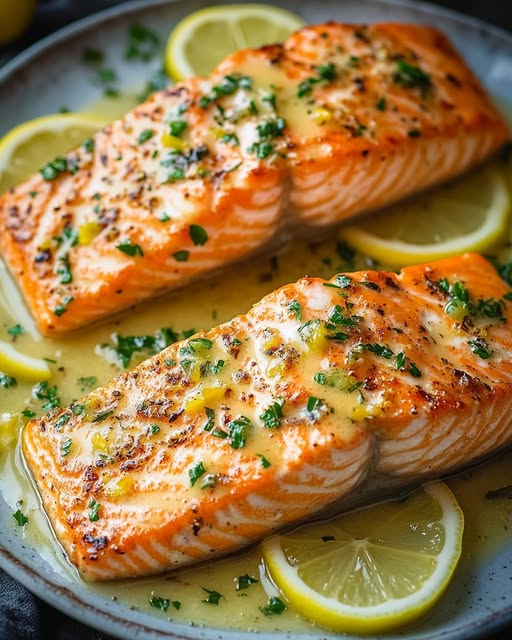Why You’ll Fall in Love with Lemon Garlic Salmon
Picture this: a weeknight dinner that feels like a fancy restaurant meal but takes less time than ordering takeout. That’s exactly what happened when I first made Lemon Garlic Salmon. It was one of those evenings where I had zero energy, yet my family was craving something special. With just a handful of ingredients and 20 minutes, I whipped up this dish. The aroma of garlic sizzling in butter filled the kitchen, and the tangy brightness of lemon made everyone’s eyes light up. Trust me, once you try this recipe, it’ll become your go-to for quick, delicious meals.
The Story Behind Lemon Garlic Salmon
This dish has deep roots in French cuisine, where butter, lemon, and garlic are often paired to create rich yet balanced flavors. While traditional recipes might call for heavy cream or wine, this version keeps things light and approachable. I’ve always been a fan of simple recipes that let fresh ingredients shine. When I tested this recipe, I was amazed at how the humble combination of lemon, garlic, and butter transformed ordinary salmon into something extraordinary. Plus, it’s versatile enough to suit both casual family dinners and elegant dinner parties.
Why You’ll Love This Recipe
First off, this Lemon Garlic Salmon is ridiculously easy to make. If you can melt butter and squeeze a lemon, you’re halfway there. The dish is packed with flavor—savory garlic, zesty lemon, and creamy butter come together in perfect harmony. It’s also healthy! Salmon is loaded with omega-3 fatty acids, and the sauce is light enough to keep things balanced. Whether you’re cooking for yourself or impressing guests, this recipe delivers on taste, simplicity, and presentation.
Perfect Occasions for Lemon Garlic Salmon
This dish is perfect for busy weeknights when you need something quick but don’t want to sacrifice flavor. It’s also a great option for date night or hosting friends because it feels indulgent without requiring hours in the kitchen. I’ve served it at holiday gatherings, pairing it with roasted vegetables and mashed potatoes, and it’s always a hit. Honestly, any occasion where you want to feel like a culinary rock star is ideal for this recipe.
Ingredients List
- 4 salmon fillets (about 170g each), skinless, about 2.5 cm thick
- Salt and freshly ground black pepper
- 2 teaspoons olive oil
- 2 garlic cloves, minced
- ¼ cup low-sodium chicken broth
- 2 tablespoons fresh lemon juice
- 3 tablespoons unsalted butter, cut into pieces, plus 1 teaspoon for sautéing
- ½ teaspoon honey
- 2 tablespoons fresh parsley, chopped
- Lemon slices for garnish (optional)
Substitution Options
If you’re out of chicken broth, vegetable broth works just as well. For a dairy-free version, swap the butter with olive oil or a plant-based butter alternative. Fresh lemon juice is key for brightness, but if you’re in a pinch, bottled juice can work—just make sure it’s high quality. And if you’re not a fan of parsley, try dill or chives for a different herbaceous twist.
Step-by-Step Preparation
Step 1: Prepare the Salmon
Start by taking your salmon fillets out of the fridge and letting them sit at room temperature for about 10 minutes. This ensures even cooking. Pat them dry with paper towels—trust me, removing excess moisture helps achieve that beautiful golden crust. Season both sides generously with salt and freshly ground black pepper. Pro tip: Use coarse sea salt for extra flavor.
Step 2: Make the Garlic Butter Sauce
In a small saucepan over medium heat, melt 1 teaspoon of butter. Add the minced garlic and sauté until it turns lightly golden, which should take about 1-2 minutes. Be careful not to burn the garlic; burnt garlic tastes bitter and can ruin the dish. Once fragrant, pour in the chicken broth and fresh lemon juice. Let the mixture simmer until it reduces by half, concentrating all those amazing flavors.
Step 3: Cook the Salmon
Heat the olive oil in a large nonstick skillet over medium-high heat. When the oil shimmers, add the salmon fillets, presentation side down. Let them cook undisturbed for about 4 minutes, allowing a crispy crust to form. Flip the fillets gently and cook for another 2-3 minutes. The salmon is done when it flakes easily with a fork. Resist the urge to overcrowd the pan—it’s better to cook in batches if needed.
Step 4: Finish and Serve
Once the salmon is cooked, transfer it to plates. Whisk the remaining butter and honey into the reduced sauce until smooth and glossy. Spoon the sauce generously over the salmon. Sprinkle with fresh parsley and garnish with lemon slices if you’re feeling fancy. Serve immediately while everything is still warm and inviting.
Chef’s Tip
For an extra layer of flavor, zest the lemon before juicing it and sprinkle the zest over the finished dish. It adds a pop of citrusy brightness that really elevates the dish.
Timing Breakdown
- Preparation Time: 10 minutes
- Cooking Time: 10 minutes
- Total Time: 20 minutes
Extra Info
Did you know that salmon is one of the richest sources of vitamin D? It’s true! Just one serving provides a significant portion of your daily needs. Pair that with the antioxidants in fresh lemon juice, and you’ve got a powerhouse meal that’s as good for your body as it is for your taste buds.
Necessary Equipment
- Nonstick skillet
- Small saucepan
- Paper towels
- Tongs or spatula
- Whisk
Storage Tips
If you have leftovers, store them in an airtight container in the refrigerator for up to two days. Reheat gently in a skillet over low heat to preserve the texture of the salmon. Avoid microwaving, as it can make the fish dry.
For longer storage, freeze the cooked salmon without the sauce. Wrap it tightly in plastic wrap and place it in a freezer-safe bag. It will keep for up to three months. Thaw overnight in the fridge before reheating.
The sauce doesn’t freeze well, so it’s best to make a fresh batch when reheating the salmon. Simply follow the sauce instructions and drizzle it over the reheated fish for maximum flavor.
Tips and Advice
To get the crispiest sear on your salmon, make sure your skillet is hot before adding the oil. Also, don’t move the fillets around too much while they’re cooking—it disrupts the crust formation. If you’re new to cooking fish, invest in a fish spatula. Its thin, flexible design makes flipping delicate fillets a breeze.
Presentation Ideas
- Garnish with additional herbs like dill or thyme for a pop of color.
- Serve on a bed of quinoa or wild rice for a complete meal.
- Add a sprig of rosemary or a slice of lemon on top for a restaurant-worthy touch.
Healthier Alternatives
Here are six variations to make this recipe even lighter:
- Baked Version: Place the seasoned salmon on a baking sheet lined with parchment paper and bake at 400°F for 12-15 minutes. Top with the sauce before serving.
- Air Fryer Method: Spray the air fryer basket with oil, place the salmon inside, and cook at 390°F for 8-10 minutes. Drizzle with sauce afterward.
- Grilled Option: Grill the salmon over medium heat for 4-5 minutes per side. Brush with sauce during the last minute of grilling.
- Low-Sodium Twist: Skip the chicken broth entirely and use water with a splash of white wine for depth.
- Vegan Adaptation: Replace salmon with tofu or chickpea patties and use vegan butter for the sauce.
- Gluten-Free Choice: Ensure your chicken broth is gluten-free, and serve with gluten-free grains like cauliflower rice.
Common Mistakes to Avoid
Mistake 1: Overcooking the Salmon
Overcooked salmon becomes dry and loses its tender texture. To avoid this, remove the salmon from the heat just before it’s fully opaque—the residual heat will finish the cooking process. A good rule of thumb is to aim for an internal temperature of 125°F.
Mistake 2: Skipping the Resting Step
Letting the salmon rest for a few minutes after cooking allows the juices to redistribute. Without this step, the fish may seem drier than it actually is. Patience pays off here!
Mistake 3: Using Old or Bottled Lemon Juice
Fresh lemon juice makes a world of difference in this recipe. Bottled versions often lack the vibrant acidity needed to balance the richness of the butter and salmon. Always opt for fresh lemons for the best results.
FAQ Section
Can I Use Frozen Salmon?
Absolutely! Just thaw it completely in the fridge overnight before using. Pat it dry thoroughly to ensure proper searing.
What Can I Substitute for Honey?
Maple syrup or agave nectar works wonderfully as a substitute for honey in the sauce.
How Do I Know When the Salmon Is Done?
The salmon is ready when it flakes easily with a fork and reaches an internal temperature of 125°F. Avoid guessing—use a meat thermometer for accuracy.
Can I Double the Recipe?
Yes, but cook the salmon in batches to prevent overcrowding in the pan. Doubling the sauce is straightforward and won’t affect the outcome.
Is This Recipe Gluten-Free?
Yes, as long as you use gluten-free chicken broth. All other ingredients are naturally gluten-free.
Can I Prep This Ahead of Time?
You can prep the sauce ahead and reheat it gently before serving. However, it’s best to cook the salmon fresh for optimal texture.
What Sides Go Well with This Dish?
Roasted vegetables, steamed broccoli, or a simple green salad pair beautifully with Lemon Garlic Salmon.
How Long Does Leftover Sauce Last?
Store leftover sauce in the fridge for up to two days. Reheat gently on the stove and whisk to recombine.
Can I Use Skin-On Salmon?
Yes, but adjust the cooking time slightly. Start skin-side down and flip only once the skin is crispy.
What If I Don’t Have Chicken Broth?
Vegetable broth or plain water with a splash of white wine works as a substitute. Adjust seasoning accordingly.
Final Thoughts
Lemon Garlic Salmon is more than just a recipe—it’s a lifesaver for busy nights and a showstopper for special occasions. With its bold flavors, quick prep time, and versatility, it’s no wonder this dish has earned a permanent spot in my kitchen. Give it a try, and let me know how it turns out. Happy cooking!

Lemon Garlic Salmon
Ingredients
Equipment
Method
- Let the salmon fillets sit at room temperature for about 10 minutes, then pat them dry and season with salt and pepper.
- In a small saucepan over medium heat, melt 1 teaspoon of butter, add minced garlic, and sauté until golden, about 1-2 minutes.
- Pour in chicken broth and lemon juice, and simmer the mixture until it reduces by half.
- Heat olive oil in a large nonstick skillet over medium-high heat and add the salmon fillets, cooking for about 4 minutes without moving them.
- Flip the fillets and cook for another 2-3 minutes until they flake easily with a fork.
- Transfer the salmon to plates, whisk in the remaining butter and honey into the reduced sauce, and drizzle it over the salmon.
- Garnish with parsley and lemon slices, then serve immediately.
